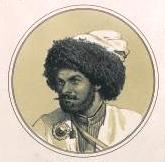Haji Murat
Hadschi Murat ( Russian Хаджи-Мурат ) (* late 1790s in Tselmes, Dagestan ; † May 5, 1852 in Azerbaijan ) was during the Murid War (1827-1859) alongside Imam Shamil an important leader in the resistance struggle of the North Caucasian peoples of Dagestan and Chechnya against the Russian occupiers .
Life
Hadji Murat was Muslim and belonged to the people of the Avars on. He lived at a time when Russia was conquering the North Caucasus . In addition, many indigenous principalities became Russian protectorates (protective states) in order to join the Russian state after a series of internal reforms and to admit the princely families into the nobility of Russia. Principalities and tribes that opposed Russia were subjugated militarily. Haji Murat's family was closely related to the Avar Nuzal Khan of Chunsach , allies of the Russians .
When, around 1825, the mystical current in Islam , Sufism, became the basis for uniting the (traditionally feuding) mountain peoples in order to defend themselves in a war (Ghazawat) against Russian expansion and allied local princes, they refused Avar khans started this fight and asked the Russian command in Tbilisi for help. This uprising movement, the " Murids ", was founded by the preacher of the Sufism current ( Tariqa ) of the Nakschibendis , Mullah Mohammed. Haji Murat became one of his first political followers and spiritual students before the later leaders of the Murid movement Ghazi Muhammad (1827–32), Hamzat Bek (1832–34) and Shamil (1834–59). The requested help was not given to the Avar Nutzal Khan and the Murids under Hamzat Bek executed almost the entire Khan family. In the same year (1834) Hajji Murat avenged his blood brothers and killed Hamzat Bek during a Friday prayer . Shamil was his successor.
Hajji Murat fought on the side of the Russians for a while until his rival in the Russian service, Major Ahmet Khan, slandered him to the generals: as a traitor and saboteur in the service of Shamil. He was arrested. During a transport he managed to escape by throwing himself into an abyss. He survived seriously injured; the soldiers thought he was dead.

Disappointed by the Russians, after his recovery he finally joined Imam Shamil, who appointed him his deputy (Naip). Several tribes followed Haji Murat and fell away from the Russians. Haji Murat's strategic abilities and his daring made him a popular hero among the mountain peoples and a notorious opponent for the Russians who brought them bitter defeats.
In 1851, however, Shamil appointed his son, and not his deputy, to be the next imam, which was not acceptable to Hajji Murat, and a scandal ensued. In a secret meeting he was sentenced to death by Shamil and his council - but warned in good time. He escaped, but his family was captured.
Hadschi Murat surrendered himself to the Russian Commander-in-Chief of the Southern Army, Prince Mikhail Semjonowitsch Voronzow, in Tbilisi. He asked for Cossacks and weapons in order to free his family and destroy the common enemy Shamil; there was no answer. The famous Caucasian warrior was courted in the salons and held up in the offices. He was only allowed to retreat to a small Muslim town with his handful of followers, under the guard of Cossacks.
From this small town, Nucha in Azerbaijan, on the morning of May 5, 1852 (April 23, Julian calendar ), he and his people broke out towards the mountains of Dagestan to save his family. They killed their guards, but in the course of their escape an irrigated rice field was their undoing. In the evening they were still in it and were caught. Hajji Murat and his followers fled to a small medieval castle. Muslim militias and artillery came to the aid of the Russian persecutors . In the battle that followed, Haji Murat fell. The son of his enemy Ahmet Khan hit the dead man's head off and sent him to Tbilisi, where he embalmed and the Czar Nicholas I was sent.
Reception by Tolstoy
Lev Tolstoy himself was with the troops in the Caucasus when Hajji Murat defected to the Russians in late 1851. He wrote to his brother:
“If it is important to you to tell your acquaintances the latest from the Caucasus, you can tell that a certain Hajji Murat, the most important figure after Shamil, submitted to the Russian government a few days ago. That was the most determined guy (a jigit from all of Chechma), and yet he committed the meanness. ”(Tbilisi, December 23, 1851)
50 years later, he had revised his judgment on the meanness. In his last work, the novella Hadschi Murat , he largely adheres to historical and biographical processes. For Tolstoy, the material offered the opportunity to address the resentment of Russians towards Caucasians; to put the Muslim culture in dialogue with the Christian Orthodox culture; as well as a welcome opportunity to cover the mighty powers of his country with satire.
Reception in the film
His life is thematized in the film " Hadschi Murad - Under the Knout of the Tsar " from 1959 (original title 'Agi Murad il diavolo bianco').
Web links
literature
- Lesley Blanch : The Sabers of Paradise
- Lev Tolstoy: Haji Murat
- Lev Tolstoy: letters
swell
- ↑ Hadji Murad - Under the lash of the Czar in the Internet Movie Database (English)
| personal data | |
|---|---|
| SURNAME | Murat, Hajji |
| ALTERNATIVE NAMES | Хаджи-Мурат (Russian) |
| BRIEF DESCRIPTION | Caucasian freedom fighter during the Murid Wars (1834-1859) |
| DATE OF BIRTH | 18th century |
| PLACE OF BIRTH | Tselmes, Dagestan |
| DATE OF DEATH | May 5, 1852 |
| Place of death | Azerbaijan |
